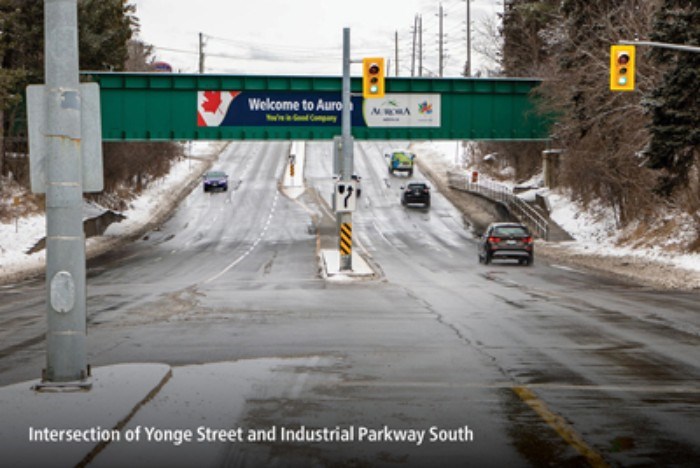Efforts to repair a sinkhole on Yonge Street near Industrial Parkway South have limited traffic for months, but it will still be a few months before the road is fully re-opened, according to engineers.
Last week, engineers behind the sinkhole repair project provided a status update to Aurora council.
The sinkhole is a result of a natural dip in Yonge Street meeting a high water table.
Engineers said they experienced multiple “unavoidable” delays in the project and now expect the project to be complete by this fall – just in time for Metrolinx to replace the nearby railway bridge for double-tracking.
“This project is a little bit like fixing a leaky bathtub when the bathtub is still filled with water,” said engineer Mark Nykoluk. “Because of all the water collecting at this location, sinkholes have been forming here for over a decade.”
The work being carried out at the busy intersection includes restructuring and expanding an “infiltration gallery” under Yonge Street. This entails a series of underground pipes with perforations to “whisk away the underground water.”
“The water collected in the…pipes will flow by gravity into the adjacent storm sewers and then into Tannery Creek,” said Nykoluk.
Once complete, the pipes will be buried beneath a layer of sand, with a layer of concrete on top of that before the asphalt is laid down on top for the roadway.
The project was initially supposed to be completed by the end of last spring, but work hit a snag shortly after work began.
“We discovered underground conditions were not as expected,” said the engineer. “This meant that one of our permits (for pumping water with the Province) needed revision. With the COVID situation, this permit revision took a little bit longer than typical, but did arrive in the fall of 2020, which allowed the work to continue. Once the work resumed, however, another challenge arose. More thought had to go into the dewatering plan and more dewatering wells were installed. The additional wells have been installed down the centre of Yonge Street. Pumping has now resumed and is planned to continue during the winter months to minimize project duration and impacts to pedestrians, cyclists and the travelling public.
“We’re also concerned with the impacts Yonge Street lane restrictions are having with the travelling public. If we have to draw down more water than presently allowed though, the second permit may need to be revised and that could take time. But we factor this into our decision-making since we know we need to complete the project in 2021 to make room for Metrolinx’s new bridge coming in 2022.”
Following Nykoluk’s presentation, however, some councillors expressed a degree of frustration around the ongoing delays.
“In my 25-year history in the town, this is not the first time we’re doing this repair,” said Councillor Gallo, asking what confidence the region had that this will ultimately fix the problem.
The region’s engineers pointed to similar work they carried out last year on Bayview Avenue, in this case between Elgin Mills Road and 19th Avenue, which not only achieved objectives but garnered awards along the way.
Councillor Wendy Gartner added this is the third time this issue has arisen since she was first elected to council and questioned how things “just went so badly wrong.”
“We didn’t go wrong,” countered Nykoluk. “What happened was we installed one well to check the composition of the water and to calculate the quality. It was during the construction that the composition of the water was different from what we had determined during our design. When there is a high ground water table, sometimes it is a little difficult to put a lot of wells into the ground, but we did do a number of geotechnical boreholes and we looked at the composition of the soils, but it was actually the water itself that caused us a bit of a problem and that was the change condition. We found zinc in the water that wasn’t there in any of the testing before and it was through the Ministry of The Environment… they determined that we could proceed with the project, but we did need to revise that permit.”
On the part of Councillor Rachel Gilliland, she asked the representatives for their worst case scenario. Things, she said, would be worse with water as spring approaches, snow and ice melts and the water table rises again.
“We’re all familiar with rising levels due to climate change that is going on,” she said. “I am not fully confident we’re not going to need to go back and pump more water.”
This is an eventually the engineers said they were prepared for.
“The surface water isn’t the problem,” said Nykoluk. “It’s the water that is underground. That really shouldn’t…be a problem in the spring. What is flowing underneath should be pretty similar to what we have experienced so far. In terms of our liaising with the Ministry of the Environment, we have a great reputation and a great resource with them. We have built that into our timelines should we need to go back and have a further permit.”
Brock Weir is a federally funded Local Journalism Initiative reporter for The Auroran



